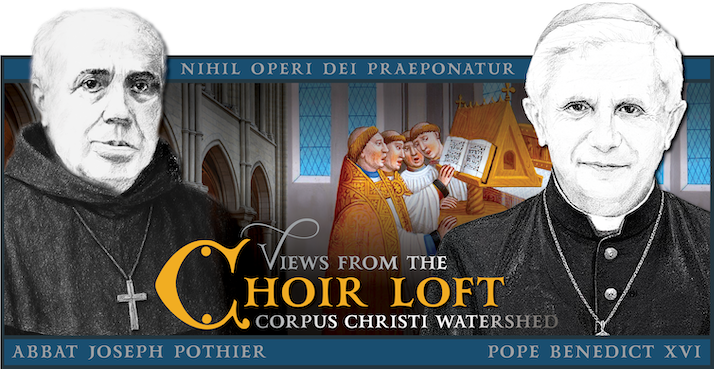 OR EVERY RULE, there is an exception. Our blog is 100% dedicated to positive things: providing more than 85,000 free musical scores, articles, instructional films, Mp3 recordings, rehearsal videos, and so forth. But if you search hard enough, you’ll discover an occasional article highlighting something scandalous in the Church. Sunshine is the best disinfectant. In 2019, we posted a video from Germany with truly offensive “sacred music” for Ash Wednesday. Within 48 hours, it received approximately 40,000 views. Then YouTube (and other film-hosting companies) removed it. Their actions were reprehensible as the video is covered under the “fair use” doctrine.1 Two years later, I was notified that somebody is going around banning—in spite of the “fair use” doctrine—the video from numerous platforms. It was posted on Facebook and within 24 hours garnered 35,000 views before Facebook ‘canceled’ the video. It’s remarkable that people are spending such energy making sure nobody sees the video yet they weren’t ashamed to use such music at Mass.
OR EVERY RULE, there is an exception. Our blog is 100% dedicated to positive things: providing more than 85,000 free musical scores, articles, instructional films, Mp3 recordings, rehearsal videos, and so forth. But if you search hard enough, you’ll discover an occasional article highlighting something scandalous in the Church. Sunshine is the best disinfectant. In 2019, we posted a video from Germany with truly offensive “sacred music” for Ash Wednesday. Within 48 hours, it received approximately 40,000 views. Then YouTube (and other film-hosting companies) removed it. Their actions were reprehensible as the video is covered under the “fair use” doctrine.1 Two years later, I was notified that somebody is going around banning—in spite of the “fair use” doctrine—the video from numerous platforms. It was posted on Facebook and within 24 hours garnered 35,000 views before Facebook ‘canceled’ the video. It’s remarkable that people are spending such energy making sure nobody sees the video yet they weren’t ashamed to use such music at Mass.
This video keeps
being removed illegally
although it falls under
the “fair use” category:
* Direct Download • 22.4MB
—Download this video file directly from GloriaTV.
* Direct Download • 22.4MB
—Download this video file directly from a Google Mirror.
* Complete Mass • On YouTube
—Ash Wednesday Mass • Basilica of St. Cunibert (6 March 2019).
* Watch Video • On GloriaTV
—Watch this video on GloriaTV.

Ash Wednesday’s True Music
Now, let us speak of the real music for Ash Wednesday; I don’t know any feast which makes greater use of tone painting. For instance, consider “Juxta Vestíbulum,” which is one of the antiphons sung during the distribution of ashes. The theme of “weeping before the Lord” is quite prominent on Ash Wednesday:
In another antiphon for the distribution of ashes—“Immutémur Hábitu”—we again find very mournful melodies:
Something happens Ash Wednesday which, as far as I know, is unique in the repertoire of Cantus Gregorianus, viz. a musical motif gets repeated in the different chants. Juxta Vestíbulum has it:
![]()
The Communion Antiphon also has it:
![]()
Another chant sung while the ashes are distributed—“Emendémus In Mélius,” famously set by composers like Pierre de Manchicourt (d. 1564) and Father Cristóbal de Morales (d. 1553)—has the melody three times:
![]()
The Ash Wednesday Entrance Antiphon (“Miseréris Ómnium Dómine”) has the motif twice:
![]()
Many more beautiful instances could be cited. For example, the way “Atténde Dómine” is set sounds like we are “calling out” to God.
![]()

Father Frederick Oakeley
Canon Frederick Oakeley (d. 1880) was a Catholic priest and disciple of Saint John Henry Newman. He was best known for the Christmas Carol: “O Come, All Ye Faithful.” Canon Oakeley published a book of hymns called Lyra Liturgica. I’m curious to know what readers think of this Ash Wednesday hymn:
* PDF Download • ASH WEDNESDAY HYMN
—By Canon Frederick Oakeley (d. 1880), a Catholic priest.
Perhaps these verses seems a little “quaint” compared to the hymn texts chosen for professional liturgical collections, such as the Brébeuf hymnal. Yet, Canon Oakeley’s was inspired by his love for God, and that’s very important!
![]()


1 The “fair use” would take too long to describe in detail. It allows tiny excerpts of videos and articles to be shared freely.
![]()









